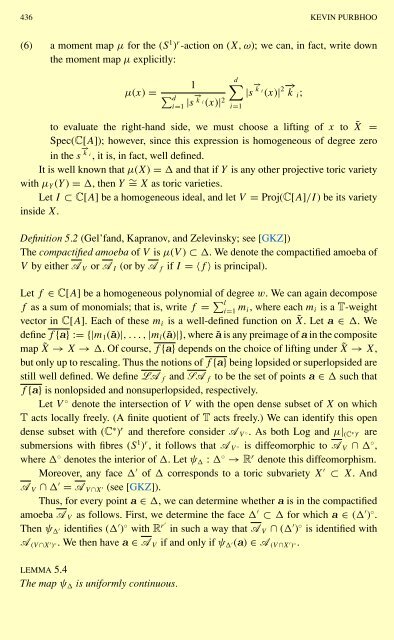A NULLSTELLENSATZ FOR AMOEBAS
A NULLSTELLENSATZ FOR AMOEBAS
A NULLSTELLENSATZ FOR AMOEBAS
You also want an ePaper? Increase the reach of your titles
YUMPU automatically turns print PDFs into web optimized ePapers that Google loves.
436 KEVIN PURBHOO<br />
(6) a moment map µ for the (S 1 ) r -action on (X, ω); we can, in fact, write down<br />
the moment map µ explicitly:<br />
µ(x) =<br />
1<br />
∑ d<br />
i=1 |s−→ k i(x)| 2<br />
d∑<br />
|s −→ k i<br />
(x)| 2−→ k i ;<br />
to evaluate the right-hand side, we must choose a lifting of x to ˜X =<br />
Spec(C[A]); however, since this expression is homogeneous of degree zero<br />
in the s −→ k i<br />
, it is, in fact, well defined.<br />
It is well known that µ(X) = and that if Y is any other projective toric variety<br />
with µ Y (Y ) = , thenY ∼ = X as toric varieties.<br />
Let I ⊂ C[A] be a homogeneous ideal, and let V = Proj(C[A]/I) be its variety<br />
inside X.<br />
Definition 5.2 (Gel’fand, Kapranov, and Zelevinsky; see [GKZ])<br />
The compactified amoeba of V is µ(V ) ⊂ . We denote the compactified amoeba of<br />
V by either A V or A I (or by A f if I =〈f 〉 is principal).<br />
Let f ∈ C[A] be a homogeneous polynomial of degree w. We can again decompose<br />
f as a sum of monomials; that is, write f = ∑ l<br />
i=1 m i, where each m i is a T-weight<br />
vector in C[A]. Each of these m i is a well-defined function on ˜X. Leta ∈ . We<br />
define f {a} := {|m 1 (ã)|,...,|m l (ã)|}, where ã is any preimage of a in the composite<br />
map ˜X → X → . Of course, f {a} depends on the choice of lifting under ˜X → X,<br />
but only up to rescaling. Thus the notions of f {a} being lopsided or superlopsided are<br />
still well defined. We define LA f and SA f to be the set of points a ∈ such that<br />
f {a} is nonlopsided and nonsuperlopsided, respectively.<br />
Let V ◦ denote the intersection of V with the open dense subset of X on which<br />
T acts locally freely. (A finite quotient of T acts freely.) We can identify this open<br />
dense subset with (C ∗ ) r and therefore consider A V ◦. As both Log and µ| (C ∗ ) r are<br />
submersions with fibres (S 1 ) r , it follows that A V ◦ is diffeomorphic to A V ∩ ◦ ,<br />
where ◦ denotes the interior of . Letψ : ◦ → R r denote this diffeomorphism.<br />
Moreover, any face ′ of corresponds to a toric subvariety X ′ ⊂ X. And<br />
A V ∩ ′ = A V ∩X ′ (see [GKZ]).<br />
Thus, for every point a ∈ , we can determine whether a is in the compactified<br />
amoeba A V as follows. First, we determine the face ′ ⊂ for which a ∈ ( ′ ) ◦ .<br />
Then ψ ′ identifies ( ′ ) ◦ with R r′ in such a way that A V ∩ ( ′ ) ◦ is identified with<br />
A (V ∩X ′ ) ◦.Wethenhavea ∈ A V if and only if ψ ′(a) ∈ A (V ∩X ′ ) ◦.<br />
LEMMA 5.4<br />
The map ψ is uniformly continuous.<br />
i=1
















